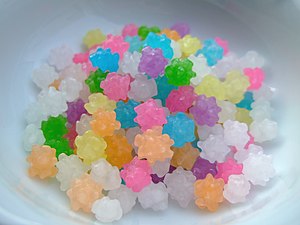Kompeitō

Konpeitō in various colors
|
|
| Type | Confectionery |
|---|---|
| Place of origin | Japan |
| Main ingredients | Sugar, water |
| |
|
Konpeitō (金平糖, コンペイトー?), also spelled kompeitō, is a Japanese sugar candy. They are often colored but unflavored.
The word "konpeitō" comes from the Portuguese word confeito (comfit), which is a type of sugar candy. This technique for producing candy was introduced to Japan in the early 16th century by Portuguese traders. The infrastructure and refining technology of sugar had not yet been established in Japan in those days. As konpeito uses a lot of sugar, it was very rare and expensive as a result. In 1569, Luís Fróis, a Portuguese missionary, presented a glass flask of konpeitō to Oda Nobunaga in order to obtain the permit for mission work of Christianity.
By the Meiji period, konpeito had already been culturally prescribed as one of the standards of Japanese sweets — the character Sugar Plum Fairy in the Nutcracker was translated into konpeitō no sei (Japanese: 金平糖の精, Fairy of konpeitō).Konpeitō is also the standard of the thank-you-for-coming gift which is given by the Imperial House of Japan. The gift of konpeitō comes in a small box called bonbonieru (Japanese: ボンボニエール), from the French bonbonnière, meaning candy box.
The characters 金平糖 (lit. "golden flat sugar") are ateji selected mostly for their phonetic value, and the word can also be written 金米糖 or 金餅糖.
...
Wikipedia
